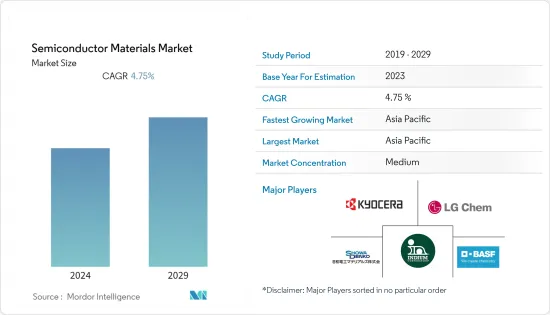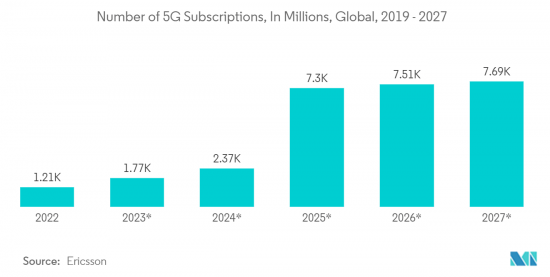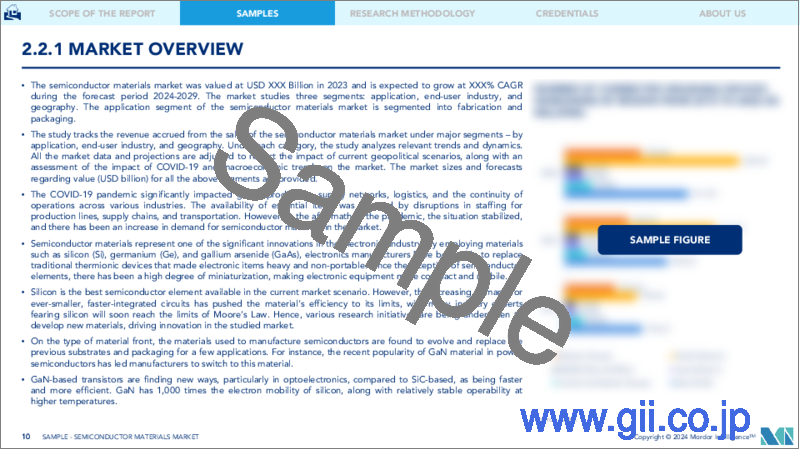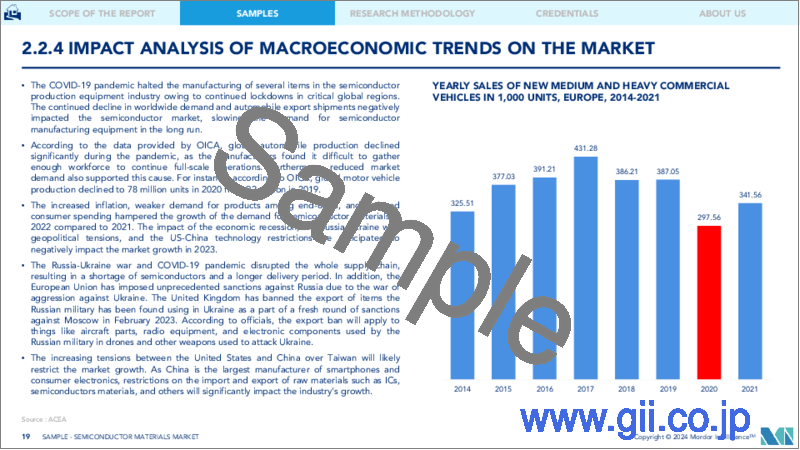|
|
市場調査レポート
商品コード
1404465
半導体材料:市場シェア分析、産業動向と統計、2024~2029年の成長予測Semiconductor Materials - Market Share Analysis, Industry Trends & Statistics, Growth Forecasts 2024 - 2029 |
||||||
|
● お客様のご希望に応じて、既存データの加工や未掲載情報(例:国別セグメント)の追加などの対応が可能です。 詳細はお問い合わせください。 |
|||||||
| 半導体材料:市場シェア分析、産業動向と統計、2024~2029年の成長予測 |
|
出版日: 2024年01月04日
発行: Mordor Intelligence
ページ情報: 英文 199 Pages
納期: 2~3営業日
|
- 全表示
- 概要
- 目次
半導体材料の市場規模は、今年度で703億米ドルと推定されます。
予測期間中のCAGRは4.75%で、今後5年間で886億6,000万米ドルに達すると予想されています。半導体材料は、エレクトロニクス産業における重要な技術革新のひとつです。シリコン(Si)、ゲルマニウム(Ge)、ガリウムヒ素(GaAs)などの材料を使うことで、電子機器メーカーは、電子機器を重く高価にする従来の熱電子デバイスに取って代わることができます。半導体デバイスのイントロダクション以来、高度な小型化が進み、電子デバイスはより小型でモバイルに対応するようになった。

主要ハイライト
- 半導体業界では微細化の動きが加速しており、先進ノードIC、ヘテロジニアス・インテグレーション、3Dメモリー・アーキテクチャの製造にはより多くの処理工程が必要となるため、半導体材料の需要も拡大すると予想されます。
- 半導体はリジッド基板から、よりフレキシブルなプラスチック材料や紙へと移行しつつあります。よりフレキシブルな基板への動向は、発光ダイオードから太陽電池やトランジスタに至るまで、数多くのデバイスを生み出してきました。
- 半導体産業は微細化とともに成長を続けており、この分野の進歩や革新は川下のあらゆる技術に直接影響を与えています。ハイエンド・パッケージング・ソリューションに対する需要の急増とパッケージング・コストの上昇に伴い、OSATベンダーはすべてのエンドユーザー産業、特に民生用電子機器と自動車用アプリケーションからの需要が大幅に急増するのを目の当たりにしました。
- 半導体産業は、さまざまな製品の製造に関わる500以上の処理工程や、不安定なエレクトロニクス市場や予測不能な需要など、産業従事者が直面する厳しい環境のため、最も複雑な産業のひとつです。と考えられています。製造工程の複雑さにもよるが、半導体ウエハー製造だけでも最大1,400もの工程があります。最下層にトランジスタが形成され、多くの回路が組み合わされて最終製品が出来上がるという工程が繰り返されます。
- ロシア・ウクライナ戦争は半導体のサプライチェーンに影響を与えています。半導体や電子部品を製造するための原材料の重要なサプライヤーであり、様々な機器を含みます。紛争はサプライチェーンを混乱させ、これらの原材料の不足と価格上昇を引き起こし、メーカーに影響を与え、エンドユーザーのコスト上昇につながる可能性があります。
- さらに、UkraineInvestによると、銅価格は2022年3月上旬に10,845米ドル/トンまでエスカレートしました。ロシアとウクライナの戦争が続いていること、エネルギーコストが高いこと、欧州で排ガス規制が厳しくなっていることなどが、銅が不足し続けている主要原因として指摘されています。
半導体材料市場の動向
家電製品の需要増が市場を牽引
- コンシューマ・エレクトロニクス(CE)は数十億米ドル規模の産業を形成しており、ライフスタイルの変化に向けて、着実に技術を進歩・発展させ、新しい製品ラインを増やしています。IoTの出現により、さまざまなエンドユーザー産業が、業務を強化するために高度な家電製品を採用するようになっています。
- シスコによると、モノのインターネット(IoT)は、人、プロセス、デバイス、データがインターネットや相互に接続する一般的なシステムとなっています。M2M接続は、2018年の61億から2023年には世界全体で147億に成長すると予測されています。さらにシスコは、2023年までに世界の人口1人当たり1.8台のM2M(マシン・ツー・マシン)接続が存在すると予測しています。
- 2023年までに、固定機器とモバイル機器を含む全デバイスに占める消費者の割合は74%となり、企業が残りの26%を占めることになります。しかし、シスコによると、消費者のシェアは、CAGR12.0%と予想されるビジネス・セグメントに比べ、CAGR9.1%と、やや緩やかな成長率になるといわれています。
- NB-IoTやCat-Mのような大規模なIoT技術(主に、バッテリ寿命が長くスループットが低い、低コストで低複雑度のデバイスを大量に含む広域使用事例)の展開が拡大しているため、Cat-MやNB-IoT技術によって接続されるIoTデバイスの数は、2023年には2G/3G接続のIoTデバイスを追い越すと予想されます。2027年のブロードバンドIoTは、当時の全セルラーIoT接続の51%を占める(出典:Ericsson)。このような動向は、コンシューマー・エレクトロニクス産業の展望を大きく変えることが予想され、その結果、接続機能をサポートする半導体チップの需要も高まると思われます。
- このセグメントの半導体の主要な消費者はスマートフォン市場です。スマートフォン市場は近年非常に競争が激しくなっています。携帯電話の利用が増加していることが、世界市場を牽引すると予想されています。例えば、Ericssonによると、スマートフォンの契約数は2021年の63億から2027年には78億に達すると予想されています。
- その他、需要拡大の大きな原動力となっているのは、5Gの展開とIoTです。通信事業者が5G技術への投資と立ち上げに関心を高めていることから、5G対応機器への需要が高まり、消費者や産業界が5G対応機器を選ぶようになると予想されます。例えば、エリクソンによると、5Gモバイル加入者数は2020年の2億7,396万人から2021年には6億6,418万人に増加し、2027年には世界全体で43億8,977万人に達すると予想され、その過程で半導体チップと半導体材料の需要を牽引します。
- 5Gネットワークは、基地局に多数のアンテナを配置するマッシブMIMOを採用しており、半導体チップが広く使用されています。したがって、5Gは予測期間中、調査対象市場にとって大きなチャンスとなります。

著しい成長を遂げる中国
- 中国政府の国家戦略計画「Made in China 2025」は、同国の半導体産業の成長にとって重要な要素となっています。この計画の中心目標は半導体産業の成長です。さらに、中国国家知識産権局(CNIP)の2021年度予算では、2023年までに年間200万件の登録を目標としており、半導体材料市場の活性化が期待されています。
- 中国政府が2021年3月に発表した2021~25年の新5カ年計画では、基礎研究の強化が重要な優先課題として掲げられています。基礎研究に対する中央政府の支出は2021年に11%増加する見込みで、研究開発投資全体の計画7%、GDP(国内総生産)成長率の目標6%を大きく上回る。半導体は、優先的に資金と資源を提供すべき7つの分野の1つに挙げられています。設計会社は、コンピューティング、ストレージ、ネットワーク接続、電力管理など、電子機器を機能させる重要なタスクを実行するナノスケールの集積回路を開発しています。
- さらに、ウェアラブル電子機器の成長も、新しい小型化チップの採用につながっており、半導体の成長を促進し、ウエハー需要を増加させ、研究市場をさらに牽引しています。シスコシステムズによると、中国の接続ウェアラブルデバイス数は、2021年の3億7,880万台から2022年には4億3,900万台に達する見込みです。また、Ericssonによると、スマートフォンのモバイルネットワーク契約数は2022年に世界で約66億に達し、2028年には78億を超えると予想されています。これにより、研究対象市場はさらに促進されると思われます。
- さらに、中国の自動車産業は増加の一途をたどっており、世界の自動車市場において中国の果たす役割はますます重要になっています。中国政府は、自動車部品部門を含む自動車産業を重要産業のひとつと位置づけています。政府は、中国の自動車生産台数が2020年までに3,000万台、2025年までに3,500万台に達すると予測しています。
- パンデミックは同国の自動車産業に顕著な影響を与えたが、最近のデータによれば、同国の自動車産業は2025年の目標に向かって順調に進んでいます。例えば、中国汽車工業協会(CAAM)によると、2021年、中国で生産される自動車の総数は約2,610万台だった。さらに2022年、自動車産業は着実な成長を報告しています。例えば、2022年9月には、国内で約260万台の自動車が販売されました。
- Semiconductor Equipment and Materials Internationalによると、2022年の中国の半導体装置からの収益は129億7,000万米ドルに達しました。半導体チップの需要拡大と製造施設・設備への投資の増加は、同市場で事業を展開するベンダーに新たな成長機会をもたらすと期待されています。
半導体材料業界概要
エンドユーザーが半導体製造業者に期待する品質の重要性を考慮すると、半導体材料市場ではブランドのアイデンティティが大きな役割を果たしています。また、BASF、L.G Chem Ltd.、KYOCERA Corporationなどの大手既存企業が存在するため、市場への浸透度も高いです。全体として、競争企業間の敵対関係は予測期間中に緩やかに成長すると予想されます。
2022年11月、米国の電子機器組立と半導体パッケージング企業に世界の材料を提供するIndium Corporationは、マレーシアのペナンに3万7,500平方フィートの最新生産工場を開設しました。新工場は製造操業を開始し、マレーシアと近隣地域、特にタイとベトナムの顧客により良いサービスを提供するために生産能力を増強します。
L.G. Chemは2022年5月、半導体後工程で使用されるフォトレジスト(P.R.)の開発を開始し、世界の半導体ビジネスに提供することを意図しています。同社は、半導体の前工程で超微細な回路設計を彫り込んだ後、チップの性能を向上させるために後工程用のP.R.を開発しています。
その他の特典:
- エクセル形式の市場予測(ME)シート
- 3ヶ月間のアナリスト・サポート
目次
第1章 イントロダクション
- 調査の前提条件と市場定義
- 調査範囲
第2章 調査手法
第3章 エグゼクティブサマリー
第4章 市場洞察
- 市場概要
- 業界の魅力度-ポーターのファイブフォース分析
- 供給企業の交渉力
- 消費者の交渉力
- 新規参入業者の脅威
- 代替品の脅威
- 競争企業間の敵対関係の強さ
- 主要マクロ動向の市場への影響評価
第5章 市場力学
- 市場促進要因
- 電子材料の技術進歩と製品革新
- 家電製品に対する需要の高まり
- OSAT/パッケージング企業からの需要増加
- 市場抑制要因
- 製造工程の複雑さ
第6章 市場セグメンテーション
- 用途別
- ファブリケーション
- プロセス化学
- フォトマスク
- 電子ガス
- フォトレジスト
- スパッタリング対象
- シリコン
- その他の製造材料
- パッケージング
- 基板
- リードフレーム
- セラミックパッケージ
- ボンディングワイヤー
- 封止樹脂(液状)
- ダイアタッチ材料
- その他のパッケージング用途
- ファブリケーション
- エンドユーザー産業別
- コンシューマー・エレクトロニクス
- 通信業界
- 製造業
- 自動車
- エネルギー・公益事業
- その他のエンドユーザー産業
- 地域別
- 北米
- 欧州
- アジア太平洋
- その他
第7章 競合情勢
- 企業プロファイル
- BASF SE
- LG Chem Ltd
- Indium Corporation
- Showa Denko Materials Co. Ltd(showa Denko K.K)
- KYOCERA Corporation
- Henkel AG & Company KGAA
- Sumitomo Chemical Co. Ltd
- Dow Chemical Co.(Dow Inc.)
- International Quantum Epitaxy PLC
- Nichia Corporation
- CAPLINQ Europe BV
- ShinEtsu Microsi
第8章 投資分析
第9章 市場の将来

The semiconductor materials market size is estimated at USD 70.30 billion in the current year. It is expected to reach USD 88.66 billion by the next five years, registering a CAGR of 4.75% during the forecast period. Semiconductor materials represent one of the significant innovations in the electronics industry. By using materials such as silicon (Si), germanium (Ge), and gallium arsenide (GaAs), electronics manufacturers can replace traditional thermionic devices that make electronic devices heavy and expensive. Since the introduction of semiconductor devices, advanced miniaturization has progressed, and electronic devices have become more compact and mobile.
Key Highlights
- With the miniaturization trend gaining momentum in the semiconductor industry, the demand for semiconductor materials is also expected to grow as manufacturing advanced node ICs, heterogeneous integration, and 3D memory architectures require more processing steps; this drives higher wafer fabrication and packaging materials consumption.
- Semiconductors are moving away from rigid substrates to more flexible plastic material and paper, all due to new material and fabrication discoveries. The trend toward more flexible substrates has led to numerous devices, from light-emitting diodes to solar cells and transistors.
- The semiconductor industry has been growing with miniaturization, and advancements and innovations in this field have directly impacted all downstream technologies. With the surging demand for high-end packaging solutions and rising packaging costs, OSAT vendors witnessed a considerable surge in demand from all the end-user industries, especially consumer electronics and automotive applications.
- The semiconductor industry is one of the most complex because of the more than 500 processing steps involved in manufacturing different products and the challenging environment faced by industry workers, including volatile electronics markets and unpredictable demand. It is considered. Depending on the complexity of the manufacturing process, there can be up to 1,400 process steps in semiconductor wafer manufacturing alone. Transistors are formed on the bottom layer, and the process is repeated as many circuits are assembled to create the final product.
- The Russia-Ukraine war is impacting the supply chain of semiconductors. Being a significant supplier of raw materials for producing semiconductors and electronic components, including various equipment. The dispute has disrupted the supply chain, causing shortages and price increases for these materials, impacting manufacturers and potentially leading to higher costs for end-users.
- Further, according to UkraineInvest, copper prices escalated to USD 10,845/mt in early March 2022. The ongoing war between Russia and Ukraine, high energy costs, and stricter emissions standards in Europe have been noted as the primary reasons for the continued shortage of copper.
Semiconductor Materials Market Trends
Rising Demand for Consumer Electronics Goods to Drive the Market
- Consumer electronics (CE) forms a multibillion-dollar industry, steadily progressing and developing technology and adding new product lines toward changing lifestyles. With the advent of IoT, various end-user industries are increasingly adopting advanced consumer electronic products to enhance their operations.
- According to Cisco, the Internet of Things (IoT) has become a prevalent system by which people, processes, devices, and data connection to the Internet and each other. M2M connections are anticipated to grow from 6.1 billion in 2018 to 14.7 billion globally in 2023. Furthermore, Cisco predicts that, by 2023, there will be 1.8 M2M (machine-to-machine) connections for each member of the global population.
- By 2023, the consumer share of the total devices, including fixed and mobile devices, will be 74 percent, with businesses claiming the remaining 26 percent. However, according to Cisco, consumer share will grow at a slightly slower rate, at a 9.1 percent CAGR relative to the business segment, which is expected to witness a 12.0 percent CAGR.
- With the growing deployment of massive IoT technologies such as NB-IoT and Cat-M - primarily consisting of wide-area use cases involving large numbers of low-cost, low-complexity devices with long battery life and low throughput, the number of IoT devices connected by Cat-M and NB-IoT technologies is expected to overtake 2G/3G connected IoT devices in 2023. Broadband IoT in 2027 made up 51 percent of all cellular IoT connections at that time (Source: Ericsson). Such trends are expected to significantly transform the outlook of the consumer electronics industry, which in turn will drive the demand for semiconductor chips to support connectivity features.
- The smartphone market is the major consumer of semiconductors in this segment. The smartphone market has been very competitive in recent years. The increasing usage of cell phones is anticipated to drive the global market. For instance, according to Ericsson, smartphone subscriptions are expected to reach 7.8 billion by 2027, from 6.3 billion in 2021.
- Other significant drivers behind the demand growth are the 5G rollout and IoT. The growing interest of telecom operators to invest and launch in 5G technology is expected to fuel the demand for 5G capable devices, where consumers and industries are expected to opt for 5G devices. For instance, according to Ericsson, 5G mobile subscription, which grew from 273.96 million in 2020 to 664.18 million in 2021, is expected to reach 4,389.77 million globally by 2027, driving the demand for semiconductor chips and semiconductor materials in the process.
- 5G networks use massive MIMO in which many antennas are deployed at the base station, wherein semiconductor chips are widely used. Therefore, 5G will offer an enormous opportunity for the market studied during the forecast period.

China to Witness Significant Growth
- The Chinese government's national strategic plan, ``Made in China 2025,'' has become a key factor in the growth of the country's semiconductor industry. A central goal of this plan is the growth of the semiconductor industry. Furthermore, the 2021 budget of the China National Intellectual Property Administration (CNIP) targets 2 million registrations per year by 2023, which is expected to revitalize the semiconductor materials market.
- China's new five-year plan for 2021-25, announced in March 2021 by the government, establishes boosting basic research as a critical priority. Central government spending on basic research was expected to increase by 11 percent in 2021, well above the 7 percent planned for the overall R&D investment and the 6 percent target for GDP (Gross Domestic Product) growth. Semiconductors have been identified as one of seven areas for priority funding and resources. Design companies develop nanoscale integrated circuits that perform important tasks that make electronic devices work, such as computing, storage, network connectivity, and power management.
- Furthermore, the growth in wearable electronic devices has also been leading to the adoption of new miniaturized chips, propelling the semiconductor's growth and increasing the demand for wafers, further driving the studied market. As per Cisco Systems, the number of connected wearable devices in China is expected to reach 439 million by 2022 from 378.8 million in 2021. Additionally, according to Ericsson, the number of smartphone mobile network subscriptions is expected to reach approximately 6.6 billion worldwide in 2022 and exceed 7.8 billion by 2028. This will further promote the studied market.
- Furthermore, China's automotive industry has been increasing, and the country plays an increasingly important role in the global automotive market. The Chinese government positions the automobile industry, including the auto parts sector, as one of its key industries. The government predicted that China's car production would reach 30 million vehicles by 2020 and 35 million by 2025.
- Although the pandemic had a notable impact on the country's automobile industry, recent data suggests that the country's automotive industry is on track to its 2025 goals. For instance, according to the China Association for Automobile Manufacturers (CAAM), in 2021, the total number of cars produced in China was about 26.1 million. Furthermore, in 2022, the automotive industry has reported steady growth. For instance, in September 2022, about 2.6 million vehicles were sold in the country.
- According to Semiconductor Equipment and Materials International, China's revenue from semiconductor equipment reached USD 12.97 billion in 2022. The growing demand for semiconductor chips and increasing investment in manufacturing facilities and equipment are expected to create new growth opportunities for the vendors operating in the market.
Semiconductor Materials Industry Overview
Brand identity plays a major role in the Semiconductor Materials market, considering the importance of quality that the end-users expect from a semiconductor manufacturing player. The market penetration is also high with the presence of large market incumbents, such as BASF, L.G Chem Ltd., and KYOCERA Corporation. Overall, the intensity of competitive rivalry is expected to grow moderately over the forecast period.
In November 2022, Indium Corporation, a worldwide materials provider to the electronics assembly and semiconductor packaging company in the United States, opened its newest 37,500-square-foot production plant in Penang, Malaysia. The new plant has begun manufacturing operations and will increase production capacity to service better the company's clients in Malaysia and the neighboring area, notably Thailand and Vietnam.
In May 2022, L.G. Chem began developing photoresist (P.R.) utilized in the semiconductor back-end processes with the intention of providing it to worldwide semiconductor businesses. After engraving ultra-fine circuit designs on the front-end procedure of semiconductors, the company is creating P.R. for the back-end technique to improve chip performance.
Additional Benefits:
- The market estimate (ME) sheet in Excel format
- 3 months of analyst support
TABLE OF CONTENTS
1 INTRODUCTION
- 1.1 Study Assumptions and Market Definition
- 1.2 Scope of the Study
2 RESEARCH METHODOLOGY
3 EXECUTIVE SUMMARY
4 MARKET INSIGHTS
- 4.1 Market Overview
- 4.2 Industry Attractiveness - Porter's Five Forces Analysis
- 4.2.1 Bargaining Power of Suppliers
- 4.2.2 Bargaining Power of Consumers
- 4.2.3 Threat of New Entrants
- 4.2.4 Threat of Substitutes
- 4.2.5 Intensity of Competitive Rivalry
- 4.3 Assessment of the Impact of Key Macro Trends on the Market
5 MARKET DYNAMICS
- 5.1 Market Drivers
- 5.1.1 Technical Advancements and Product Innovation of the Electronic Materials
- 5.1.2 Rising Demand for Consumer Electronics Goods
- 5.1.3 Increased Demand From OSAT/Packaging Companies
- 5.2 Market Restraints
- 5.2.1 Complexity in the Manufacturing Process
6 MARKET SEGMENTATION
- 6.1 By Application
- 6.1.1 Fabrication
- 6.1.1.1 Process Chemicals
- 6.1.1.2 Photomasks
- 6.1.1.3 Electronic Gases
- 6.1.1.4 Photoresists Ancilliaries
- 6.1.1.5 Sputtering Targets
- 6.1.1.6 Silicon
- 6.1.1.7 Other Fabrication Materials
- 6.1.2 Packaging
- 6.1.2.1 Substrates
- 6.1.2.2 Lead-frames
- 6.1.2.3 Ceramic Packages
- 6.1.2.4 Bonding Wire
- 6.1.2.5 Encapsulation Resins (Liquid)
- 6.1.2.6 Die Attach Materials
- 6.1.2.7 Other Packaging Applications
- 6.1.1 Fabrication
- 6.2 By End User Industry
- 6.2.1 Consumer Electronics
- 6.2.2 Telecommunication
- 6.2.3 Manufacturing
- 6.2.4 Automotive
- 6.2.5 Energy and Utility
- 6.2.6 Other End User Industries
- 6.3 By Geography
- 6.3.1 North America
- 6.3.2 Europe
- 6.3.3 Asia Pacific
- 6.3.4 Rest of the World
7 COMPETITIVE LANDSCAPE
- 7.1 Company Profiles
- 7.1.1 BASF SE
- 7.1.2 LG Chem Ltd
- 7.1.3 Indium Corporation
- 7.1.4 Showa Denko Materials Co. Ltd (showa Denko K.K)
- 7.1.5 KYOCERA Corporation
- 7.1.6 Henkel AG & Company KGAA
- 7.1.7 Sumitomo Chemical Co. Ltd
- 7.1.8 Dow Chemical Co. (Dow Inc.)
- 7.1.9 International Quantum Epitaxy PLC
- 7.1.10 Nichia Corporation
- 7.1.11 CAPLINQ Europe BV
- 7.1.12 ShinEtsu Microsi




